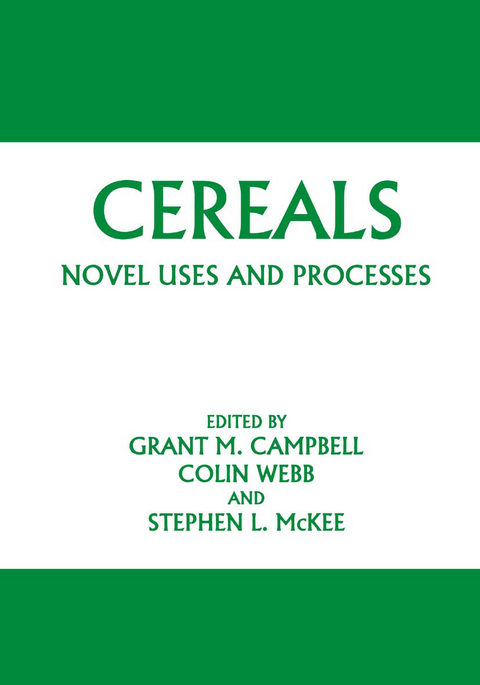
Cereals: Novel Uses and Processes
Springer-Verlag New York Inc.
978-1-4419-3274-7 (ISBN)
"So long as a person is capable of self renewal they are a living being. " -Amiel Cereals have been the source of life to the human race, providing nutritional and ma terial needs since the dawn of civilization. As with all dynamic industries, the Cereal in dustry has renewed itself in the past; as the millennium approaches, it is on the brink of another renewal, in which the versatility and providence of cereals are being rediscovered, but in new and exciting ways. Cereals are richly diverse; over 10,000 varieties convert minerals and the energy of the sun into a bursting catalog of functional and versatile biomolecules and biopolymers. Processing technology allows these components to be accessed, separated, isolated and purified, while chemical science allows modification for even greater diversity and speci ficity. The last century has seen the move from cereal- to oil-based chemical and materials industries. But cereals contain a greater variety and functionality of macromolecules than oil. Starch, protein, bran and straw, already diverse across cereal varieties, can be fraction ated into more specific elements, modified chemically to enhance function, or used as feedstocks in fermentation-based bioconversion systems, to produce a range of bulk and fine chemicals for industries as diverse as food, pharmaceuticals, plastics, textiles, pulp and paper, transport, composites and boards, adhesives and energy.
1. The Potential of Cereals as Industrial Raw Materials: Legal, Technical, and Commercial Considerations.- 2. Present and Future Uses of Cereal Starches.- 3. Industrial Markets for UK-Grown Cereal Starch.- 4. Flexible Polyurethane Foam Extended with Corn Starch.- 5. Biodegradable Composites of Starch and Poly(Hydroxybutyrate-Co-Valerate) Copolymers.- 6. Biodegradable Coatings for Thermoplastic Starch.- 7. Industrial Applications for Levulinic Acid.- 8. Production of Lactic Acid from Starch: Simulation and Optimization.- 9. On-Line Monitoring of Enzymatic Bioprocesses by Microdialysis Sampling, Anion Exchange Chromatography, and Integrated Pulsed Electrochemical Detection.- 10. Cereal Starches: Properties in Relation to Industrial Uses.- 11. Grain Composition of Amaranthaceae and Chenopodiaceae Species.- 12. Developing Specialty Starches from New Crops: A Case Study Using Grain Amaranth.- 13. Removal Characteristics of Baked Wheat Starch Deposits Treated with Aqueous Cleaning Agents.- 14. Application of Cereal Proteins in Technical Applications.- 15. Mechanical and Barrier Properties of Wheat Gluten Films Coated with Polylactic Acid.- 16. On-Line Measurement of Bran in Flour by Image Analysis.- 17. Pretreatment of Agricultural Crop Residues for Conversion to High-Value Products.- 18. Innovative Uses of Cereals for Fructose Production.- 19. Straw as a Fuel.- 20. Food and Non-Food Uses of Immature Cereals.- 21. A Closed Biotechnological System for the Manufacture of Nonfood Products from Cereals.- 22. Reduction of the Environmental Impact of Wheat Starch and Vital Wheat Gluten Production.- 23. Bioethanol from Cereal Crops in Europe.- 24. Determining the Profitability of a Wholecrop Biorefinery.- 25. Development of a Generic Fermentation Feedstock from Whole Wheat Flour.- 26. The Effect of Nutrients and ?-Amylase Inactivation on the Fermentative Lactic Acid Production in Whole Wheat Flour Hydrolysate by Lactococcus lactis ssp. lactis ATCC 19435.- 27. Agricultural Residues and Cereals as Fermentation Media.- 28. Functional Foods for Health: Opportunities for Novel Cereal Processes and Products.- 29. Novel Natural Products from Grain Fractionation.- 30. Application of Fermented Flour to Optimise Production of Premium Crackers and Bread.- 31. Neuronal and Experimental Methodology to Improve Malt Quality.- 32. Flour Milling Process for the 21st Century.- 33. Sorghum Processing Technologies in Southern Africa.- 34. Cereal Processing in New Zealand: Inversion, Diversification, Innovation, Management.
| Erscheint lt. Verlag | 29.10.2010 |
|---|---|
| Zusatzinfo | XVIII, 290 p. |
| Verlagsort | New York, NY |
| Sprache | englisch |
| Maße | 178 x 254 mm |
| Themenwelt | Naturwissenschaften ► Biologie ► Biochemie |
| Naturwissenschaften ► Biologie ► Botanik | |
| Naturwissenschaften ► Biologie ► Zoologie | |
| Naturwissenschaften ► Chemie ► Anorganische Chemie | |
| Technik ► Umwelttechnik / Biotechnologie | |
| Weitere Fachgebiete ► Land- / Forstwirtschaft / Fischerei | |
| ISBN-10 | 1-4419-3274-7 / 1441932747 |
| ISBN-13 | 978-1-4419-3274-7 / 9781441932747 |
| Zustand | Neuware |
| Informationen gemäß Produktsicherheitsverordnung (GPSR) | |
| Haben Sie eine Frage zum Produkt? |
aus dem Bereich


